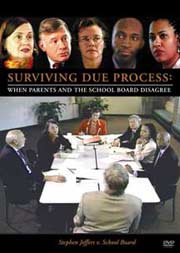|
Reading is a learned skill. For many children, reading is not a skill that develops naturally.
Children do not learn to read with "support". They learn to read with direct instruction.
Both IDEA 2004 and NCLB address teaching children to read. One purpose of NCLB is "to ensure that every student can read at grade level or above . . . [by] the end of grade 3."
When IDEA 2004 was reauthorized, Congress incorporated many NCLB requirements to make these laws consistent.
In this issue of the Special Ed Advocate you'll learn about the factors that put children at risk of poor reading. You'll also learn how to prevent reading difficulties, how to foster literacy from birth, and learn about evidence-based reading research of the best ways to teach reading.
Please don't hesitate to forward this issue of the Special Ed Advocate to other families, friends, and colleagues.

Sign up free today! l Read previous issues |
|
The Nation's Report Card on Reading |
In How to Prevent Reading Difficulties and Reading Failure, Sue Whitney, Research Editor at Wrightslaw, summarizes research on how a child becomes a reader.
According to the Nation's Report Card for 2005, 37 percent of fourth graders
were proficient readers - and more nearly 60 percent were not proficient.
The percentage of eighth graders whose reading skills were "below
basic" increased since the National Assessment in 2002.
In 2007, the nation's average reading scores were higher than in 1992 in both grade 4 and grade 8, but there was no significant change in the percentage of students at or above the proficient level.
The Nation's Report Card for 2007 indicated that 33 percent of 4th grade readers were proficient - and more nearly 67 percent were not proficient. The percentage of 8th graders at the basic level increased in 2007, yet there was no increase in proficient readers.
Most children with disabilities have significant deficits in reading. But most children do not receive appropriate research-based reading instruction so they never learn to read proficiently.
|
back to the top |
|
| How Do We Prevent Reading Difficulties and Failure? |
If we want our children to learn to read, we do not offer "support". We offer direct, specific, and intensive reading instruction.
Children should be taught word identification, comprehension, and reading development.
In How to Prevent Reading Difficulties and Reading Failure, Sue provides a comprehensive list of resources about how children learn to read, how to prevent reading failure, and how to implement research based instruction. These resources come from respected organizations including:
- National Reading Panel
- National Institute for Literacy
- U. S. Department of Education
More about Reading at Wrightslaw |
back to the top |
|
Teaching Children to Read: What is the Best Approach? |
In 1997, because reading scores had not improved in 30 years, Congress asked the National Institutes of Health to convene a national panel to assess the effectiveness of different approaches used to teach children to read. In 2000, the National Reading Panel (NRP) released its findings.
In How to Prevent Reading Difficulties and Reading Failure you'll find links to the following: the summary of this report, a guide that summarizes the findings, and a video about how to teach children to read.
"Teaching Children to Read"- Summary Report of the National Reading Panel - This report is an excellent resource for parents, teachers, administrators, or anyone interested in learning about reading instruction research.
Put Reading First: The Research Building Blocks for Teaching Children to Read - This guide summarizes the findings of the National Reading Panel and suggests how to use these findings to teach reading in the classroom. Describes the five areas of reading instruction: phonemic awareness, phonics, fluency, vocabulary, and text comprehension, implications for classroom instruction, and examples of how the findings can be implemented.
Teaching Children to Read Video, 2nd Edition - This video describes the findings of the National Reading Panel and evidence-based reading research about the best ways to teach reading. This video is ideal for parents, teachers, and anyone concerned about reading instruction and how to better teach children to read.
Go to How to Prevent Reading Difficulties and Reading Failure to download copies of the reports and the video. |
back to the top |
|
| Early Intervention and Prevention |
We know that early identification and early intervention are essential to educating children with disabilities.
We also know that "if help is delayed until third grade, children rarely catch up with their peers ... 75% of children who were poor readers in the 3rd grade remained poor readers in the 9th grade and could not read well when they became adults."
If you have a young child, you'll find reading tips, information about skills kids need to read, and activities for parents with young children at Get Ready to Read.
Note: You'll also find a Screening Tool designed for four-year-olds. This 20 question research based screening tool will determine if your child's pre-reading skills are weak, strong, or in between.
Get Ready to Read Screening Tool in Spanish.
Meet Sue Whitney
Sue Whitney, Research Editor at Wrightslaw is the co-author of Wrightslaw: No Child Left Behind.
In Doing Your Homework, she writes about reading, research based instruction, No
Child Left Behind, and creative strategies for using federal education standards to advocate for children and to improve public schools.
For more about her work with families as a Special Education Advocate, go to her website at www.suewhitney.com.
|
|
back to the top
|
|
|







